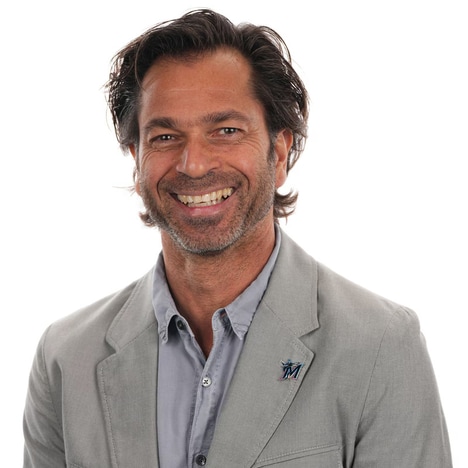Reimagining Baseball's Cultural Connection
An Interview with Tiago Pinto, Chief Marketing Off Miami Marlins
 In a city defined by constant transformation where 42% of residents are foreign-born — more than any other major US market — the Miami Marlins face a unique challenge: how do you market America's oldest pastime to an audience that's perpetually in flux? For Chief Marketing Officer Tiago Pinto, this dynamic landscape doesn't present an obstacle but rather a canvas for continuous innovation.
In a city defined by constant transformation where 42% of residents are foreign-born — more than any other major US market — the Miami Marlins face a unique challenge: how do you market America's oldest pastime to an audience that's perpetually in flux? For Chief Marketing Officer Tiago Pinto, this dynamic landscape doesn't present an obstacle but rather a canvas for continuous innovation."The existence of the Marlins is based on the need to innovate, reinnovate, and constantly look forward," Pinto explains. "We're in a market that is the epitome of urban innovation and transformation in America today."
Leading a team of 30 professionals across six departments, Pinto is responsible for orchestrating the entire consumer journey — from the initial invitation to the ballpark, to creating memorable experiences during games, to leveraging data that brings fans back for more. His approach to sports marketing in this vibrant, multicultural metropolis offers valuable lessons for any brand navigating rapidly evolving consumer landscapes.
1. What does innovation mean to you?
Innovation means changing the status quo and opening up opportunities to redefine how things work. Ultimately, it's the only way to unlock incredible gains in margins. If things have been done before, people have already put a value to them. But for things that have never been done before – if you're the one leading it, you determine the value for your consumers. It's about reinventing the business and, most importantly, rediscussing the value of things.
2. How is AI transforming your approach to fan engagement?
One thing I'm particularly excited about is how we're using AI to reinvent a baseball tradition. Every team creates a presentation video for their players – typically, you sign new players in the off-season, make a video introducing them so people know their faces, and play this mood-setting video pre-game when the team is about to take the field.
A couple of years ago, we asked ourselves, "What else can we create? What if we create a world that doesn't exist?" We partnered with a company called The Famous Group and implemented an AI strategy that created an imaginative version of Miami that only exists in this presentation, only exists here when we're introducing the team.
This AI-generated approach dramatically improved the logistics of shooting the video because we control the environment. Every off-season, new players can be easily integrated into this magical Miami that only exists at the ballpark. AI has been a tremendous enabler in terms of both technology and cost efficiency.
Last year, we received very positive reviews from various publications noting there was something new in this decades-old discipline of creating game opening videos. We believe this resonates with what our fans expect and what connects with the market. Now we're looking at what's next, because you always have to come with something new. That's the beauty of sports – a new season, a new dawn. You have to invent things because people expect something different. It makes sports an exciting industry for innovation.
3. How does your team generate new ideas?
This is baseball, right? We need to promote 81 home games. It's very easy to run out of ideas, so you really need to dig deeper. What helps us most is running in the city of Miami – a city in complete and constant transformation. With 42% of our residents being foreign-born, more than any other large market in the US, we operate in an environment that doesn't allow you to market baseball the way traditional baseball cities like New York, Boston, or St. Louis do, where "baseball is baseball" and it's been the same for 160 years.
For us, it's different – people are coming and going. Our fans are constantly new. You continuously have to invite them to come to the ballpark. So when we think about innovation, it's really about having our finger on the pulse of the market and understanding what people might expect and what could potentially make them want to come to our ballpark and become interested in the Marlins.
4. Do you have specific rituals for resetting your team to be creative?
I don't think we need to be told to be creative – that's what we do. We have weekly rituals where we kick off the week with a team meeting. During the season, we recap what happened over the weekend, what needs to be done further, what worked, and what didn't work.
We're constantly out in the community dealing with influencers, schools, little leagues, and families here at the ballpark. I think the first step with innovation starts with understanding your consumer – understanding your landscape and what your consumers are asking for, but most importantly, foreseeing what they're not asking for yet but will demand in the future. That's the space that's ripest for innovation.
You really need to understand your business, the landscape, and your consumers, because consumers expect leading brands to show them the way. If you're just asking what your consumers want and delivering exactly that, you're never going to be an innovator or a leader.
5. What is the biggest challenge you face when innovating?
The word "innovation" means it's never been done before, so there's no roadmap, and you always encounter risks. I like to say if you're not failing, it's because you're not taking enough risks. Innovation is assuming the risk of the journey and embarking on it anyway.
We've created things here that were too ahead of their time and took a while to come to fruition. There are other things we thought were the coolest ideas that fell flat because people weren't interested. The challenge of innovation is an everyday thing. To me, it's about having the attitude to keep improving and not letting yourself get too discouraged if something doesn't work. What's important is understanding why it didn't work and applying that learning to future endeavors.
6. Has there ever been an instance where another industry has influenced an innovation at the Marlins?
Absolutely – every day. Good ideas are good ideas; you just have to understand the insight that led to that innovation and whether that insight is applicable to your industry.
I constantly see ideas and think, "I wish I could have had that idea." Some are applicable to the Marlins business, some are not. To me, it's about how we take those learnings and apply what's relevant. Sometimes it's not just about replicating exactly what others did – it's about understanding the problem they were trying to solve and the question they had in mind. If that's applicable, then the solution might be completely different here in a different industry. That curiosity about someone else's curiosity is what leads you to be able to apply others' ideas to your business.
7. What makes an innovative culture? How do you create a culture of innovation?
Allowing for risk is essential. If you're too contrived, you're never going to have any innovation. If you don't allow people to take risks and sometimes fail, then people aren't going to innovate. People like their jobs and we have fun here, so you need to let your team try something different to see if it works. If it doesn't work, nobody loses their job – we're just going to try again and improve in the future.
That's the most important part of the culture – being an environment that allows for experimentation, that doesn't just praise success but praises learning. Sometimes the results aren't there, but the learning is. If you praise learning, you praise innovation.
8. Looking to the future, how will the Marlins continue to be a leader in innovation?
We're rooted in the South Florida community, which will always drive innovation because things are always changing. There's always someone trying to outdo you, and it's a market that constantly second-guesses itself.
Look at what Formula One is doing in Miami – every year, they reinvent what the Grand Prix is, and they're clear that if they don't reinvent themselves, people simply won't show up again. And that's just one event a year. We put on 81 events during the regular baseball season, so we really have to reinvent ourselves.
This year, for example, we're known for having post-game concerts, but as part of our innovation, we're hosting those concerts on the field after games. So people can not only watch the game but then step onto the field where, just minutes before, the best players in the world were playing baseball, and watch world-famous concerts. We're featuring two big names in South Florida – Luis Fonsi meets Flo Rida – playing one after the other after the game.
Has this been done before in some way? Maybe. But in this format? Never. We have to try it, and next year we'll have to up our game again because fans will say, "You've done that before. Now what?" It's a city and a market that demands that kind of constant innovation, and we need to respond.
References: mlb


